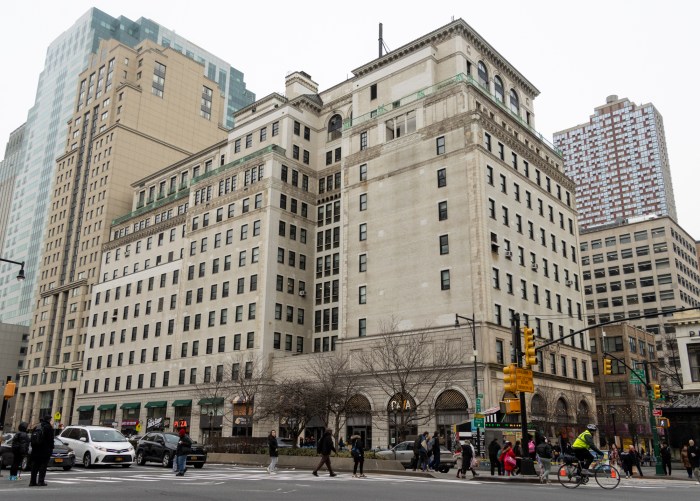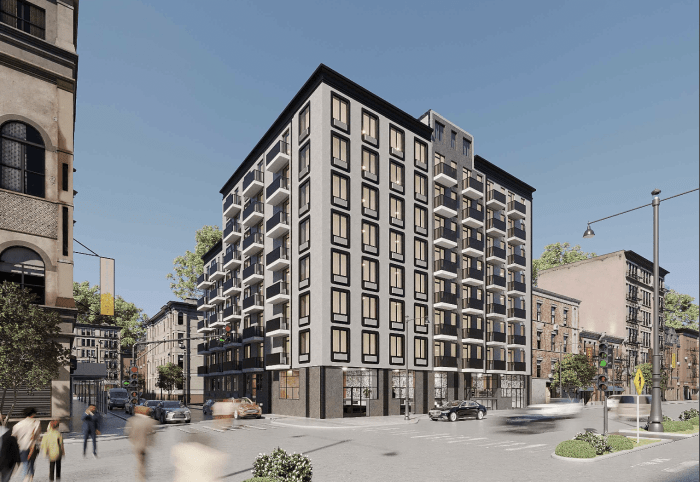Scores of Brooklynites rallied on Tuesday to support a plan to tear down a row of historic, yet badly damaged, houses inside the Brooklyn Navy Yard to make room for a supermarket — even as the federal government issued a report declaring that most of the 10 150-year-old mansions can be saved.
“Let’s build the supermarket!” Councilwoman Letitia James (D–Fort Greene) told a crowd of about 75 Brooklynites before a public hearing at an elementary school at Gold and York streets. “Let’s create jobs for the community. Let’s integrate the Navy Yard into the community. If you want a supermarket, say yes!”
“Yes!” echoed the crowd behind her.
Admirals Row, the collection of mansions that overlooks Flushing Avenue near Navy Street, is at a critical juncture. The mansions sit on six acres of federally owned land within the otherwise city-controlled Navy Yard.
The National Guard wants to sell the land, and according to local law, must give the city first dibs. But because of the houses’ historic significance, the Guard must also go through an arduous public comment and historic review process. If, at the end of that process, the Guard determines that the houses should be saved, it can refuse to sell them to the city, or it can sell them to the city with the understanding that they must be preserved.
If the city isn’t interested, the Guard can sell the houses and the land to someone else.
The city has said repeatedly that it isn’t interested.
Navy Yard CEO Andrew Kimball wants to tear them down to make way for a supermarket and a new employment center that would place 500 area residents in jobs.
He does not support an alternative plan that would require the restoration of some or all of the mansions.
“If we’re required to rebuild any or all of the buildings, you will shrink the supermarket, lose hundreds of jobs on the site, and it won’t happen, because it is not viable,” said Kimball.
The draft copy of the National Guard’s Assessment of Admirals Row said that the houses, which retain “an extremely high level of historic integrity,” would cost about $25 million to fully restore.
“In general, the structural integrity for the original 19th century portions of the buildings’ superstructure appears to be sound, level and plumb, showing localized areas of framing failures and masonry distress, with the exception of [two] buildings,” read the report.
Kimball countered that just because a building can be restored, doesn’t mean it should be.
“You can rebuild anything,” said Kimball. “It’s a question of price.”
On the other hand, the report’s conclusions jibe with the assertions of neighborhood preservationists, particularly those in the higher-income neighborhoods of Fort Greene and Clinton Hill.
“A number of contractors with whom I work on various restoration projects say that they would jump at the opportunity to rebuild the Admirals Row houses,” said Brent Porter, a professor of architecture at Pratt Institute, who proposed that Pratt host a design competition for the houses.
Shahn Andersen, the developer who has worked with Porter to rebuild the Broken Angel, that handmade ziggurat on Downing Street, said he’s “restored houses in worse shape than these.”
Regardless, the city’s plan has wide support in the neighboring public housing projects, and is backed by public officials and Community Board 2, which voted overwhelmingly in favor of the supermarket on Wednesday night.
Sylvenia Leary, who lives in the Farragut Houses and walks with the help of a cane, said at the hearing Tuesday night that the food at her neighboring small grocery store “is sometimes expired, and sometimes we have to return the meat because it’s not good.”
Darnell Canada, an Ingersoll resident and the founder of REBUILD, which helps formerly incarcerated men get jobs, added that, “elderly people are going crazy just trying to get the basic necessities. … [And] do you want to look at a building, or do you want jobs?”
But not all of his neighbors agreed. Edward Carter, a veteran of the Korean and Vietnam wars and a half-century resident the Walt Whitman Houses, said, “Admirals Row should be made into a veterans center.”
Some neighbors were open to compromise. Gary Hattem, who lives a block and a half from the Navy Yard, said that he hopes to see a supermarket, but believes “this can be accomplished without [the] wholesale demolition of Admirals Row.”
The National Guard may end up agreeing.“There is no telling [what the outcome will be],” said Kristin Leahy, the manager of the National Guard Bureau Cultural Resources Program.
“We have to sit down with both parties and try to come up with a compromise.”
























